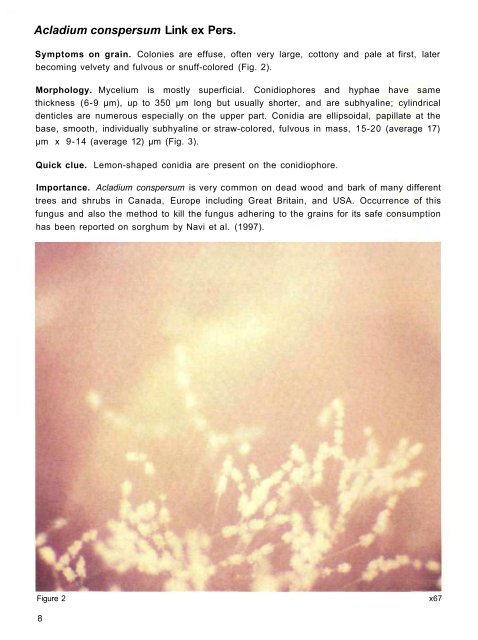A Pictorial Guide for the Identification of Mold ... - OAR@ICRISAT
A Pictorial Guide for the Identification of Mold ... - OAR@ICRISAT
A Pictorial Guide for the Identification of Mold ... - OAR@ICRISAT
Create successful ePaper yourself
Turn your PDF publications into a flip-book with our unique Google optimized e-Paper software.
Acladium conspersum Link ex Pers.<br />
Symptoms on grain. Colonies are effuse, <strong>of</strong>ten very large, cottony and pale at first, later<br />
becoming velvety and fulvous or snuff-colored (Fig. 2).<br />
Morphology. Mycelium is mostly superficial. Conidiophores and hyphae have same<br />
thickness (6-9 μm), up to 350 μm long but usually shorter, and are subhyaline; cylindrical<br />
denticles are numerous especially on <strong>the</strong> upper part. Conidia are ellipsoidal, papillate at <strong>the</strong><br />
base, smooth, individually subhyaline or straw-colored, fulvous in mass, 15-20 (average 17)<br />
μm x 9-14 (average 12) μm (Fig. 3).<br />
Quick clue. Lemon-shaped conidia are present on <strong>the</strong> conidiophore.<br />
Importance. Acladium conspersum is very common on dead wood and bark <strong>of</strong> many different<br />
trees and shrubs in Canada, Europe including Great Britain, and USA. Occurrence <strong>of</strong> this<br />
fungus and also <strong>the</strong> method to kill <strong>the</strong> fungus adhering to <strong>the</strong> grains <strong>for</strong> its safe consumption<br />
has been reported on sorghum by Navi et al. (1997).<br />
Figure 2 x67<br />
8
















